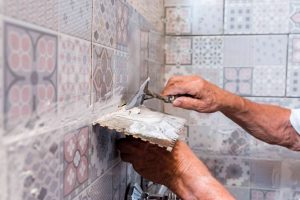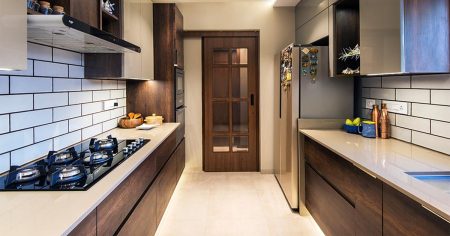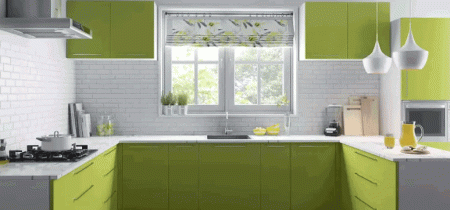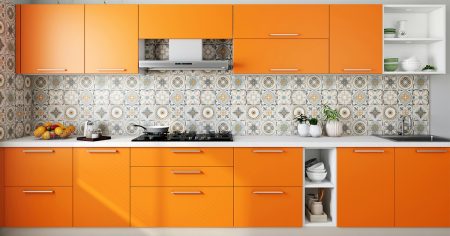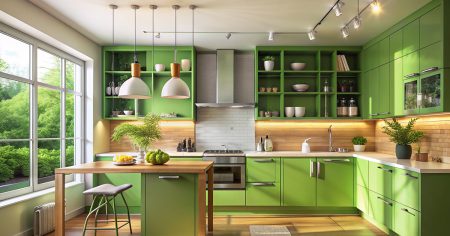The purpose of kitchen flooring is to provide a flat, comfortable place to walk, stand, and navigate while preparing food, serving meals, and cleaning up the kitchen. Due to the high volume of foot traffic, kitchen flooring needs to be made with durable materials that can stand up to the daily wear-and-tear. Common kitchen flooring options include hardwood, linoleum, vinyl, natural stone, and ceramic tile.
In some kitchens, you may also see concrete, brick, bamboo, and cork flooring, though not every material can hold up in a kitchen environment. The flooring material should be resistant to heat, moisture, staining, and impact damage to ensure that the floors last for years. Balancing style, function, and comfort is the key to making the right choice for your kitchen. Here are nine durable kitchen flooring options to consider for one of the most heavily used areas of your home.
-
01
of 09Ceramic Tile
Pros: Ceramic tile isn’t the hardest flooring material used in kitchens, but it is the most durable. It’s made from natural clay that’s then shaped, glazed, and fired under extreme heat. Ceramic tile is impervious to water and stains, making it an ideal kitchen flooring option, and it’s resistant to heat and breakage.
Under good conditions, ceramic tile can last indefinitely with little change to its appearance or function over time. It’s also available in numerous colors and patterns and can take on the look of other materials, such as wood and stone.
If you can’t find a ceramic tile in the color or design you’d like, it’s perfectly fine to look for its cousin, porcelain tile, which is also suitable kitchen-flooring material, though it can be a bit more brittle.
Cons: Ceramic tile is extremely hard and can be uncomfortable to stand on. And if they’re not installed properly, they can be prone to cracking.
Best for: Water-resistance, heat-resistance, and impact-resistance.
-
02
of 09Concrete
Pros: It’s too heavy for use in many homes, but if you live in a home that doesn’t have a basement and your kitchen is at ground level, concrete may be another flooring option. This material is inexpensive and long-lasting. A concrete floor surface doesn’t need to be plain. It can be polished, stained, or creatively treated in a variety of ways to turn it into a low-maintenance and stylish work of art. For this reason, concrete floors are especially appropriate in modern kitchens.
Cons: The porous natural of concrete means that you will need to seal the surface of the floor to protect it against staining and water damage. The material can also be hard and cold underfoot, just like ceramic tile. Additionally, you may not like the unique look of concrete flooring because it can exude an urban or industrial aesthetic, which can be a challenge when trying to sell your home.
Best for: Custom design, impact-resistance, and heat-resistance.
-
03
of 09Natural Stone Tile
Pros: Natural stone is one of the most popular, durable, and long-lasting kitchen flooring options available. It exudes luxury and acts as an attractive draw for buyers when it comes time to sell your home. Different types of stone will have different properties, such as hardness, scratch resistance, and long-term durability.
Granite comes in tiles for flooring and slabs for countertops and is known for its attractive veining and durability over decades if sealed and maintained. Limestone is a soft and pretty tile typically used for countertops. It’s too soft for busy kitchens but can be used for accents in low-traffic areas. Marble is known for its elegant veining, but polished marble may be easily scratched and stained.
Sandstone is known for its soft, multicolored look. It’s not the longest-wearing natural stone but does wear well enough for use in kitchens. Slate is one of the most sophisticated stones that can last for decades when sealed and maintained. Travertine is known for its Old World style and textured surface, though it’s not the longest-wearing natural stone.
Cons: The drawback to stone is that it is porous and therefore susceptible to water and liquid stain penetration, which is a common problem in the kitchen. An annual application of a quality penetrating stone sealer can create an invisible coat of protection over the stone. Sealers need to be reapplied regularly.
Best for: Unique natural aesthetic, heat-resistance, and impact-resistance.
-
04
of 09Brick
Pros: Brick may seem like an odd choice for the kitchen, but this tough material has been used in wall and flooring construction for years. The addition of a brick kitchen floor gives the home an industrial aesthetic, similar to the look of concrete kitchen flooring.
This flooring material has a long life and a high level of durability against heat, impact damage, and abrasive damage, so users can trust that it will last for years without fail.
Cons: Brick is a porous material, so it will need to be regularly sealed to protect against staining and water damage. Typically, brick flooring can be sealed at the time of installation and resealed about once every year.
Best for: Industrial aesthetics, heat-resistance, and abrasion-resistance.
Continue to 5 of 9 below -
05
of 09Bamboo
Pros: Bamboo is becoming an increasingly popular choice for kitchens since it’s considerably more durable than wood and the manufacturing process makes the material more resistant to moisture and water damage. Bamboo flooring is a great choice for the kitchen if you want the look and feel of hardwood, but require a higher level of moisture-resistance and durability.
There are three types of bamboo flooring. Strand woven is the most durable and expensive solid bamboo flooring, made of pulped bamboo that is pressed and formed into very dense blocks of material and formed into planks. Engineered bamboo consists of flooring planks topped by a layer of bamboo and a waterproof coating. Solid bamboo is processed by bonding sliced bamboo together.
Cons: It should be mentioned that this type of flooring can look different depending on its color, grain, and pattern. Solid bamboo may not be ideal for kitchens where moisture is present.
Best for: Mimicking the look of hardwood, moisture-resistance, and superior hardness to hardwood.
Need more help? Talk to a flooring expert
Our partners can help you compare quotes from top-rated professionals near you
Get a Quote
Advertiser DisclosureThe offers that appear in this table are from partnerships from which The Spruce receives compensation.
-
06
of 09Hardwood
Pros: Hardwood is a tough, durable flooring material in most areas of the home. But, for many years, hardwood was considered a poor choice for bathrooms and kitchens, where moisture is often an issue. The perception has changed a bit for hardwood flooring thanks to modern sealers and polyurethane finishes that make the material more durable and longer-lasting for moisture-prone areas.
Hardwood in the kitchen is softer underfoot, it’s good for resale value, and it can be sanded and refinished to make it look new if becomes too aged.
Cons: You still need to use caution when choosing hardwood flooring for a kitchen. Whether it’s solid hardwood planks or engineered wood flooring featuring a hardwood veneer, the material will naturally be more susceptible to moisture problems and stains than other flooring materials. Hardwood can also easily dent and become scratched from embedded grit. It’s also difficult for DIYers to install and it can be expensive, depending on the manufacturer.
Best for: Comfort, easy refinishing, and a variety of color and style options.
-
07
of 09Vinyl
Pros: Vinyl is one of the easiest and most versatile kitchen flooring solutions. This manmade material is nearly impervious to stains and water issues, so cleaning it is as easy as a quick sweep, mop, or vacuum to keep the floor spotless.
Vinyl is among the most inexpensive and DIY-friendly of all flooring materials to install. It’s a popular choice for busy kitchens, especially those that see a lot of family use.
If you’re used to older sheet or tile styles of vinyl flooring, you’ll be pleased to learn about LVF, which stands for luxury vinyl flooring. This new generation of vinyl flooring is available in tiles and planks. The high-quality material can last up to two decades and comes in styles that can mimic wood or stone in remarkably convincing ways. Luxury vinyl is often installed in upscale homes.
Cons: Expect to replace vinyl every decade or so, as it wears and fades fast with heavy use.
Best for: Affordability, stain-resistance, water-resistance, and easy installation.
-
08
of 09Cork
Pros: Cork flooring seeks to improve the comfort of the user with a soft construction that reduces fatigue and strain from walking and standing during food preparation. This material has a unique appearance that can add to the home’s aesthetic and it is made from sustainable materials, so your conscience doesn’t need to worry about the environmental impact.
Cons: The warm flooring material is flexible and soft underfoot, but it isn’t as durable as most other flooring options. Cork flooring is vulnerable to dents, scratches, and moisture. To help prevent staining, water damage, and abrasive damage, it’s recommended to seal the flooring about once every one to two years.
Best for: Comfort, flexibility, and sustainability.
Continue to 9 of 9 below -
09
of 09Linoleum
Pros: Linoleum was a favored kitchen and bathroom flooring option up through the 1960s, but it faded from popularity as other flooring options were introduced. Today, it’s making a comeback and proving to be a contender alongside many vinyl flooring options.
Made from all-natural linseed oil, linoleum is environmentally friendly, is easy to clean and maintain, comes in a wide variety of neutral and vivid colors, and comes in elegant designs that include borders and insets.
Cons: Linoleum kitchen flooring is one of the least durable options available. It’s highly susceptible to water damage, which causes the edges of the tiles to curl inward. You may be able to avoid the problem of curling edges if you opt for the highest quality linoleum flooring or select a more water-resistant material for the kitchen.
Best for: Affordability, low-maintenance, and easy installation.
Choosing a Kitchen Flooring Material
Durability
When it comes time to choose a durable kitchen flooring material, there are several factors to keep in mind to select the right material for your home. The first consideration is more of an assessment of the individuals living in the home. If the household has young children, pets, or any adults that create similar messes, then it’s recommended to invest in a flooring material that is easy to maintain, like vinyl flooring.
Comfort
For those that want comfortable flooring to stand on while preparing meals, cork, vinyl, linoleum, and hardwood tend to be more forgiving than harder options, like brick or natural stone.
Aesthetics
The style of the flooring should also be considered while looking for new flooring for the home. Try to find flooring materials that match the aesthetic of the home and your personal design preferences.
Water Resistance
Beyond simple cleaning, some flooring materials require higher levels of maintenance, like sealing natural stone floor about once a year for improved water resistance. If you don’t like the idea of having to keep up with this maintenance, then it may be better to choose a less involved material, like hardwood or ceramic tile.
Cost
A final factor to consider is the budget of the project. Affordable materials, like vinyl and linoleum, are great for keeping renovation costs low, while premium materials, like natural stone, can drive the total cost beyond the set budget.
-
What is the easiest kitchen flooring to maintain?
Vinyl flooring is typically the easiest type of flooring material to maintain because it is stain-resistant, water-resistant, and non-porous.
-
Which flooring material is the most water resistant?
The top flooring material for water-resistance is ceramic tile, though vinyl flooring is also a good choice if your family is prone to spills.
-
Which flooring material shows the least dirt?
Generally, the best color flooring to hide dirt and dust is light grey or light brown. Dirt and dust are on full display on bright, white floors, while dust tends to show up relatively easily on dark colored floors.
-
What is the most popular kitchen flooring?
There is really no “most popular” option, though ceramic tile, vinyl, and hardwood are all common.
-
What is the most durable kitchen flooring?
Vinyl is generally the most durable kitchen flooring option.
Read the full article here




